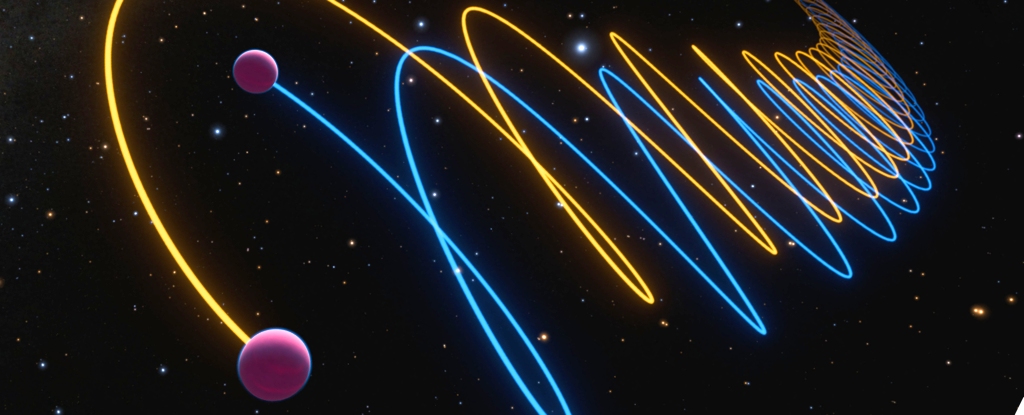In 1995, Caltech researchers at the Institute’s Palomar Observatory first observed what appeared to be a brown dwarf orbiting Gliese 229 – a red dwarf star located about 19 light-years from Earth.
Since then, this brown dwarf (Gliese 229 B) has mystified astronomers because it appeared too dim for its mass. With 70 times the mass of Jupiter, it should have been brighter than what telescopes had observed.
However, a Caltech-led international team of astronomers recently solved the mystery by determining that the brown dwarf is a pair of closely orbiting twins!
The study was led by Jerry W. Xuan, a graduate student in Caltech’s Department of Astronomy working with Dimitri Mawet, the David Morrisroe Professor of Astronomy.
They were joined by an international team from institutes and universities around the world, including the National Research Council of Canada Herzberg, the European Southern Observatory (ESO), the European Space Agency (ESA), the Laboratory of Space Studies and Instrumentation in Astrophysics (LESIA), the Center for Interdisciplinary Exploration and Research in Astrophysics (CIERA), the Max Planck Institute for Astronomy (MPIA) and Extraterrestrial Physics (MPE), and NASA’s Jet Propulsion Laboratory (JPL).
Their study, which appeared in Nature, was funded by NASA and the Heising-Simons Foundation.
The study team responsible for discovering Gliese 229 B in 1995 included several co-authors on this latest study, including Rebecca Oppenheimer, a Caltech graduate student at the time (now an astrophysicist at the American Museum of Natural History); Shri Kulkarni, the George Ellery Hale Professor of Astronomy and Planetary Science; Keith Matthews, an instrument specialist at Caltech; and other colleagues.
frameborder=”0″ allow=”accelerometer; autoplay; clipboard-write; encrypted-media; gyroscope; picture-in-picture; web-share” referrerpolicy=”strict-origin-when-cross-origin” allowfullscreen>
At the time, their findings indicated that Gliese 229 B had methane in its atmosphere, which is typical of gas giants but not stars.
These findings constituted the first confirmed detection of a brown dwarf, a class of cool star-like objects that constitute the “missing link” between gas giants and stars that had been predicted about 30 years prior.
“Seeing the first object smaller than a star orbiting another sun was exhilarating,” said Oppenheimer in a Caltech news release.
“It started a cottage industry of people seeking oddballs like it back then, but it remained an enigma for decades.”
“Gliese 229 B was considered the poster-child brown dwarf,” added Xuan. “And now we know we were wrong all along about the nature of the object. It’s not one but two. We just weren’t able to probe separations this close until now.”
Hundreds of observations have been conducted since Gliese 229 B was discovered nearly 30 years ago, but its dimness remained a mystery to astronomers.
While scientists suspected Gliese 229 B might be twins, the two brown dwarfs would have to be very close to each other to evade notice for almost three decades.
To confirm this theory, the team relied on the GRAVITY interferometer on the ESO’s Very Large Telescope in Chile to spatially resolve the two brown dwarfs.
They then used the CRyogenic high-resolution InfraRed Echelle Spectrograph (CRIRES+) instrument to detect their distinct spectral signatures and measure their Doppler shift.
Their results showed that Gliese 229 B consists of two brown dwarfs (Gliese 229 Ba and Gliese 229 Bb) about 38 and 34 times the mass of Jupiter, that orbit each other with a period of 12 days and a separation of 16 times the distance between Earth and the Moon.
The observed brightness levels also match what is expected for two small brown dwarfs in this mass range.
“This discovery that Gliese 229 B is binary not only resolves the recent tension observed between its mass and luminosity but also significantly deepens our understanding of brown dwarfs, which straddle the line between stars and giant planets,” said Mawet, a senior research scientist at NASA JPL.
The discovery of this duo raises new questions about how tight-knit brown dwarfs form and suggests similar binaries may be out there and waiting to be found.

Some theories suggest that brown dwarf pairs could form within a star’s protoplanetary disk that fragments into two seeds of brown dwarfs that become gravitationally bound after a close encounter.
The same mechanism might lead to closely orbiting exoplanet binaries, though all of this remains to be seen.
In the meantime, said Oppenheimer, this discovery is a very exciting development. “These two worlds whipping around each other are actually smaller in radius than Jupiter,” she said.
“They’d look quite strange in our night sky if we had something like them in our own solar system. This is the most exciting and fascinating discovery in substellar astrophysics in decades.”
In the future, Xuan and his colleagues plan to search for more brown dwarf binaries using existing and next-generation instruments.
This includes the Keck Planet Imager and Characterizer (KPIC) and the Keck Observatory’s High-resolution Infrared SPectrograph for Exoplanet Characterization (HISPEC). A team led by Mawet developed the former, while the latter is currently under construction at Caltech and other laboratories by teams also led by Mawet.
A separate independent study that appeared in The Astrophysical Journal Letters was led by Sam Whitebook and Tim Brandt, a Caltech graduate student and an associate astronomer at the Space Telescope Science Institute in Baltimore (respectively).
Their findings also concluded that Gliese 229 B is a pair of tightly-orbiting brown dwarfs.
This article was originally published by Universe Today. Read the original article.





